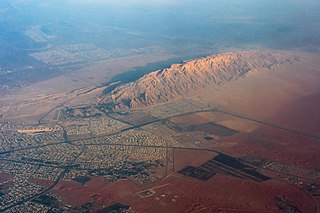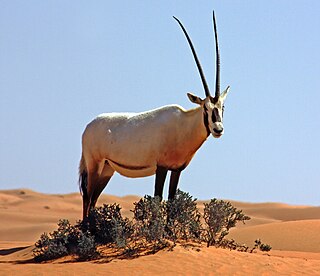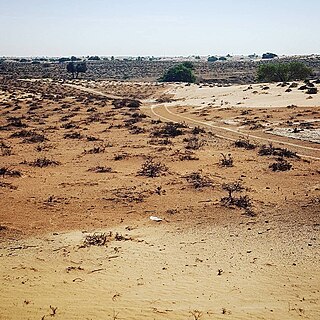
The United Arab Emirates is a country in the eastern part of the Arabian Peninsula located on the southeastern coast of the Persian Gulf and the northwestern coast of the Gulf of Oman. The UAE consists of seven emirates and was founded on 2 December 1971 as a federation,after UK armed forces left the region. Six of the seven emirates declared their union on 2 December 1971. The seventh,Ras al Khaimah,joined the federation on 10 February 1972. The seven sheikdoms were formerly known as the Trucial States,in reference to the truce treaties established with the British in the 19th century.

Al Ain is a border city on the eastern side of Tawam oasis and the seat of the administrative division,the Al Ain Region,in the Emirate of Abu Dhabi,United Arab Emirates. It is bordered to the east by the Omani town of Al-Buraimi in the Al Buraimi Governorate. It is the largest inland city in the Emirates,the fourth-largest city,and the second-largest in the Emirate of Abu Dhabi. The freeways connecting Al-Ain,Abu Dhabi,and Dubai form a geographic triangle in the country,each city being roughly 130 kilometres (81 mi) from the other two.

The Emirate of Umm Al Quwain is one of the seven constituent emirates of the United Arab Emirates,located in the north of the country. It is the second smallest and least populous emirate in the UAE and borders the Persian Gulf. Umm Al Quwain lies between Ras Al Khaimah and Sharjah/Ajman on the west coast,with a location along the vital trade route between the Middle East and India. It has a coastline stretching to 24 km.

Sheikh Zayed bin Khalifa Al Nahyan,also known as Zayed the Great or Zayed the First was the Sheikh of Abu Dhabi from 1855 to his death in 1909. He was the grandfather and namesake of Sheikh Zayed bin Sultan,founder of the United Arab Emirates.

Jabal Hafeet is a mountain in the region of Tawam,on the border of the United Arab Emirates and Oman,which may be considered an outlier of the Hajar Mountains in Eastern Arabia. Due to its proximity to the main Hajar range,the mountain may be considered as being part of the Hajar range. To the north is the UAE city of Al Ain,in the Eastern Region of the Emirate of Abu Dhabi,and the adjacent Omani town of Al-Buraimi.

Al-Aḥsāʾ,also known as al-Ḥasāʾ (الْحَسَاء) or Hajar (هَجَر),is an oasis and historical region in eastern Saudi Arabia. Al-Ahsa Governorate,which makes up much of the country's Eastern Province,is named after it. The oasis is located about 60 km (37 mi) inland from the coast of the Persian Gulf. Al-Ahsa Oasis comprises four main cities and 22 villages. The cities include Al-Mubarraz and Al-Hofuf,two of the largest cities in Saudi Arabia.

Al Buraimi Governorate is one of the 11 governorates of Oman. Until October 2006,the area was part of Ad Dhahirah Region. At this time,the new governorate was created from the Wilayats (Provinces) of Al Buraymi and Mahdah. A third wilayat,As-Sunaynah,was created from parts of the two. Sayyid Saud bin Hilal bin Hamad al-Busaidi has been governor since 2020.

Tell Abraq was an ancient Near Eastern city. Located on the border between Sharjah and Umm Al Quwain in the United Arab Emirates about 50 kilometers north-east of Dubai,the city was originally on the coastline of the Persian Gulf but changing sea levels have placed the remains of the city inland. It is located on the main road from Umm Al Quwain to Falaj Al Mualla.

The wildlife of the United Arab Emirates is the flora and fauna of the country on the eastern side of the Arabian Peninsula and the southern end of the Persian Gulf. The country offers a variety of habitats for wildlife including the coast,offshore islands,mangrove areas,mudflats,salt pans,sand and gravel plains,sand dunes,mountain slopes,wadis and rocky summits. Because the terrain is so varied,it supports a greater number of species of plants and animals than might have been expected in this relatively small country.

Ed Dur, also known as Al Dour and Ad Dour is an Ancient Near Eastern City,today located in Umm Al Quwain,in the United Arab Emirates (UAE). One of the largest archaeological sites in the emirates,comprising an area of some 5 km2 (1.9 sq mi),the coastal settlement overlooks Al Beidha Lake. One of the most important archaeological finds in the UAE,and closely associated with the inland trading centre of Mleiha,Ed Dur has been dubbed 'one of the most significant lost cities of Arabia'.

The Hafit period defines early Bronze Age human settlement in the United Arab Emirates and Oman in the period from 3200 to 2600 B.C. It is named after the distinctive beehive burials first found on Jebel Hafit,a rocky mountain near Al Ain,bordering the Rub Al Khali desert. Hafit period tombs and remains have also been located across the UAE and Oman in sites such as Bidaa bint Saud,Jebel Buhais and Buraimi.
Bidaa Bint Saud is an archaeological site in Eastern Region of the Emirate of Abu Dhabi,the U.A.E.,notable for its Hafit Period tombs,Iron Age irrigation systems and rare remains of an Iron Age building thought to have been a distribution centre for water from two aflaj. It is a listed UN World Heritage Site. Finds from the site are displayed at Al Ain National Museum.

Qattara Oasis is an area of irrigated date farm in Al Ain,United Arab Emirates featuring a distinctive falaj irrigation system as well as a late Bronze Age archaeological site dated to 1800–1500 BCE. The oasis has been extensively surveyed by students from Al Ain University since 2015,and is home to 19 buildings of varying antiquity,of which nine are mosques. Among these are thought to be some of the oldest buildings still standing in Al Ain.
The Na'im is an Arab tribe in the United Arab Emirates. The tribe is also present in other gulf countries.
The UAE's Iron Age I spanned 1,200–1,000 BCE;Iron Age II,1,000–600 BCE and Iron Age III from 600–300 BCE. This was followed by the Hellenistic Mleiha era,from 300 BCE onwards through to the Islamic era which commenced with the culmination of the 7th century Ridda Wars.
The territory currently known as the United Arab Emirates was home to three distinct Iron Age periods. Iron Age I spanned 1,200–1,000 BCE,Iron Age II from 1,000–600 BCE,and Iron Age III from 600–300 BCE. This period of human development in the region was followed by the Mleiha or Late Pre-Islamic era,from 300 BCE onwards through to the Islamic era which commenced with the culmination of the 7th-century Ridda Wars.

Tawam,also Tuwwam,Tu'am,or Al-Buraimi Oasis,is a historical oasis region in Eastern Arabia that stretched from,or was located between,the Western Hajar Mountains to the Persian Gulf coast,nowadays forming parts of what is now the United Arab Emirates and western Oman. It is marked by the twin settlements of Al Ain and Al-Buraimi on the UAE-Omani border.

Al-Buraimi is an oasis city and a wilayah (province) in northern Oman,on the border between Oman and the United Arab Emirates. It is the capital of the Al Buraimi Governorate. It is bordered by the wilayas Mahdha and Dhank. It is also bordered by the city of Al Ain in the United Arab Emirates. It is approximately 343 km away from the capital,Muscat,and has taken the motto of the Al Khandaq Fort.

The Saudi Arabia–United Arab Emirates border is 457 km (284 mi) in length and runs from the Persian Gulf coast in the west to the tripoint with Oman in the east.
The United Arab Emirates (UAE) is a relatively new country –it was formed in 1971. However,the history of the land that the UAE occupies dates back to the Neolithic Age,which is evidenced by inscriptions,drawings and archaeological finds uncovered in the seven emirates during the period from the early 1950s to the present day.















